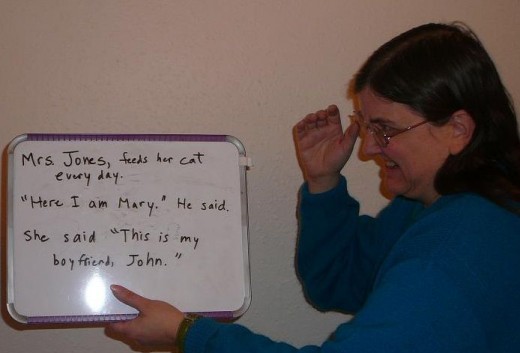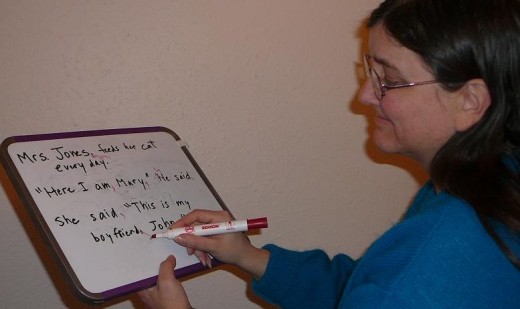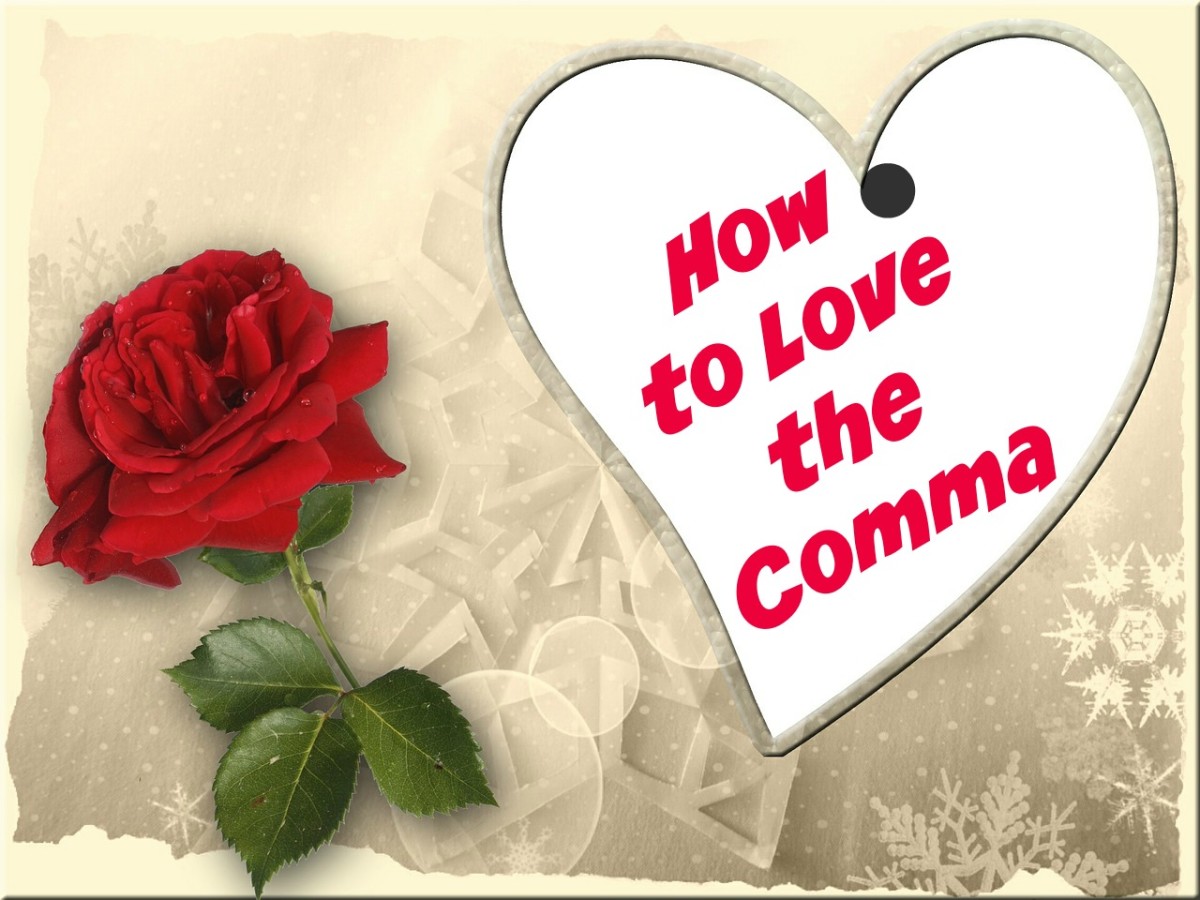Common Comma Confusions
Horrified at wrong comma usage

Second in the Series on punctuation and word use
I promised that Apostrophes for Dummies was the first of a series. However, after being corrected in one of the things I said on that Hub, I’ve been less confident to tackle another on a similar subject, especially one as hard to explain as commas. But I will do my best because I believe there is a need.
Comma misuse, like apostrophe misuse, is a plague that drives me crazy. I’m not the only one, but I’m in therapy to overcome the trauma (just kidding).
Ah, that's better!

Take a breath, but…
The purpose of a comma is to indicate certain kinds of pauses. I say certain kinds because, although comma usage is sometimes optional, one cannot use one just whenever one would choose to take a breath.
Apparently, a lot of people like to take that breath soon after the beginning of a sentence, for one common misuse I see more and more these days is putting a comma between a subject and a predicate, such as in this example:
Mrs. Jones, feeds her cat every day.
The comma here is completely unnecessary and just plain wrong. The sentence should read:
Mrs. Jones feeds her cat every day.
The only exception to this rule is when you use a phrase set off by two commas, or by a parenthetical phrase. Examples follow:
Mrs. Jones, who loves her cat dearly, feeds it every day.
Mrs. Jones (who loves her cat dearly), feeds it every day.
There will be some debate about the comma in the last example. I see the grammar checker marks it as wrong, yet I remember being taught that a comma follows a parenthetical phrase. Because the sentence is short and simple, the comma may not be necessary, but in a longer and more complex sentence, I would use it.
The same sentence could also be punctuated with dashes, thus:
Mrs. Jones—who loves her cat dearly—feeds it every day.
With dashes, a comma is not used.
Commas in Lists
I was taught in school that English accepts two different styles for commas in lists, the journalistic style (which leaves off the comma before the “and”) and the traditional style (which includes it). Newspapers, I was told, omit the final comma to save space and fit type into narrow rows more easily. However, I have just consulted Struck and White’s The Elements of Style, and it names only one style, the one I call journalistic. Since this book was written in 1918, I can’t say that the newspaper style has taken over with time. But whichever you choose, be consistent throughout the piece of writing, and it will look professional.
Examples of comma usage in lists:
Traditional style: Jack packed a violin, a tennis racket, and a Chinese fan.
Journalistic style: Jack packed a violin, a tennis racket and a Chinese fan.
If the list has only two items, no comma is necessary.
Jack packed a violin and a tennis racket.
Commas When Addressing a Person
Another common problem I see involves the need for a comma when many leave it out. Often this leads to confusion because without the comma the sentence has a completely different meaning. Consider the following example, taken from a story I recently edited for a friend:
“Here I am Mary.”
Literally, this sentence means that the person speaking is claiming to be Mary. See how what the author actually meant is made clear when a simple comma is added:
“Here I am, Mary.”
Now the speaker is plainly revealing where he is to a person named Mary.
The same rule applies when the address comes at the beginning of the sentence:
“Mary, here I am.”
If you want to place the name in the middle of the sentence, it needs to be set off by two commas:
“Here I am, Mary, by the rosebush.”
Note that if the second comma were omitted, we might think that Mary is by the rosebush.
Be careful to use commas wherever needed for clarity. Note this confusing example:
“This is my boyfriend, John.”
Is the speaker talking to John, or is the boyfriend named John? If John is the boyfriend, the comma is not necessary and leaving it out makes it clearer. A rewriting of the idea could include the person addressed, thus:
“Mary, this is my boyfriend John.”
Use Grammar and Spell Checker Judiciously
I suspect that many trust computer spelling and grammar checkers too much. I find spell checker invaluable because I still am not an expert speller. I used to be horrible, but I have worked on it diligently over the years. I don’t let my spell checker change words automatically for a number of reasons. First, if I go through every word individually and study every corrected spelling, I learn how to spell it right on my own. Second, some words and names are not recognized by spell checker and will show up as wrong. Third, spell checker will not catch words that are real words but the wrong words for your meaning. That has to be done by the writer, so I will be writing a Hub or two on frequently misused words.
The grammar checkers with which I am familiar are far from perfected. They will cite some perfectly good sentences as wrong, and suggest some sentences that don’t make sense at all. They will miss some wrong constructions as well. Grammar checker can be used if you know the rules of grammar already; it may give you options that will sound better than what you wrote in your original draft.
Commas with quotations
I have noticed an increase in misuse of punctuation related to written dialog which I thought was commonly caused by a computer grammar checker. However, when I try to reproduce the situation, my grammar checker doesn’t falsely “correct” my correct sentence. What it does do is ignore the wrong example below.
I increasingly see less punctuation-savvy writers use a period (or exclamation point or question mark) after what a person has said and a capital letter making a separate sentence of the attribution—like this, for instance:
“Give me the ball.” He said.
This example ought to be one sentence, not two, even though the words spoken form a complete sentence. Note that “He said” is not a complete sentence, and that unless it were, the “he” should not be capitalized unless you are writing about God. The following sentences are correct:
“Give me the ball,” he said.
“Give me that ball!” he shouted.
“Would you give me the ball?” he said.
He said, “Give me the ball.”
Note the use of the comma after “said” in the final example above. It is necessary, not optional.
Many Are the Books…
I expect that many are the books that could be written about comma usage. I have touched on a handful of the most common problems I see. As I run into more, I will try to write about them. I am pretty confident that I can use commas properly, but figuring out how to teach others is a challenge. I hope that this article will give you a start. I wouldn’t want to overwhelm anyone with too many rules all at once. I hope you can see that the rules are our friends because they help us to be clear in our writing. Our readers will be able to know what we are saying without having to slow down and re-read and re-think our sentences. They will appreciate our writings, and us, more.
Related Links
- Strunk, William, Jr. 1918. The Elements of Style
Strunk, William, Jr. 1918. The Elements of Style. An online version of the concise grammar classic, with a search function. - Apostrophes for Dummies
I’m a stickler for correct punctuation and word use. It seems like the rest of the world is not. Read some of the basic rules for use of apostrophes, with examples, peppered with humor. First in a series.









